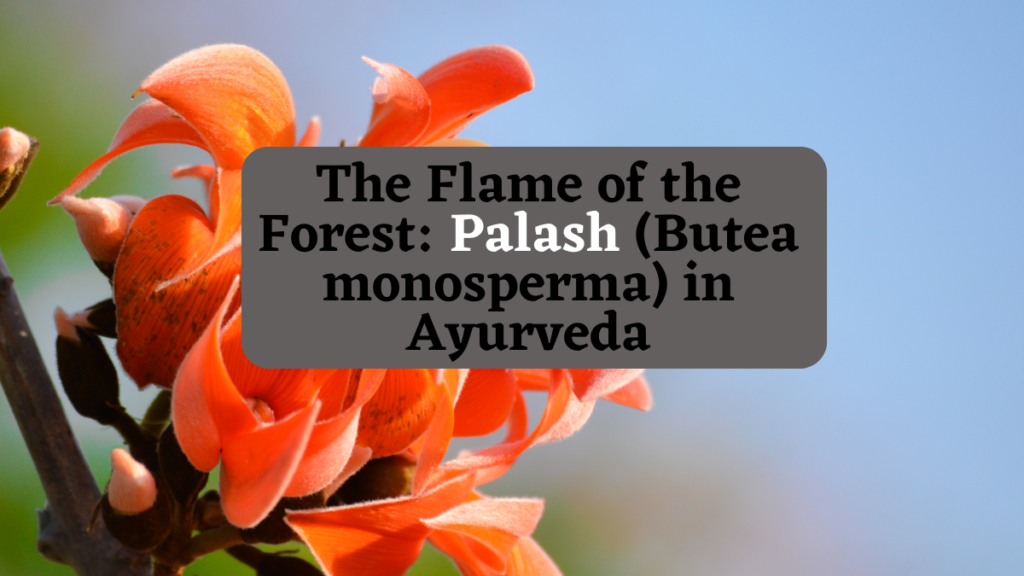The Flame of the Forest: Palash (Butea monosperma) in Ayurveda
Introduction
Adorning the Indian landscape with its fiery blooms, the Palash tree, also known as the Flame of the Forest (Butea monosperma), is more than just a visual spectacle. In Ayurveda, the ancient Indian system of medicine, Palash holds a significant place for its diverse medicinal properties.

Treasure Trove of Benefits
Ayurveda recognizes the various parts of the Palash tree – flowers, leaves, bark, and even the gum from its seeds – as possessing unique healing properties. Let’s explore some of the key benefits:
- Combats infections: Palash leaves and bark are lauded for their astringent and antimicrobial qualities. This makes them beneficial in managing diarrhea, dysentery, and even some skin infections.
- Tames inflammation: People believe that the bark and flowers possess anti-inflammatory properties, offering relief from joint pain and swelling.
- Skin savior: The antiseptic and astringent properties of Palash can be helpful in treating various skin conditions.
- Blood sugar management: Early studies suggest that Palash leaf powder might play a role in regulating blood sugar levels.
- Other benefits: Ayurveda also credits Palash with benefits like boosting immunity, promoting liver health, and even acting as an aphrodisiac.
A Word of Caution
While Palash offers a multitude of benefits, it’s important to remember that it’s a potent herb. Consulting an Ayurvedic practitioner before using Palash is essential to ensure proper dosage and avoid any potential side effects.
Beyond Medicine
The significance of Palash extends beyond its medicinal uses. The vibrant red flowers yield a natural dye, traditionally used to color textiles. Culturally, the Palash tree holds a special place in many Indian regions, symbolizing vitality and renewal.
Conclusion
The Palash tree is a true embodiment of nature’s bounty. In Ayurveda, it finds application in treating various ailments, while its vibrant beauty and cultural significance make it an integral part of Indian heritage. However, it’s crucial to consult an Ayurvedic expert before using Palash to ensure safe and effective use.
FAQ on Palash (Butea monosperma) in Ayurveda
What are the different parts of Palash used in Ayurveda?
All parts of the Palash tree have medicinal uses:
- Leaves: Used for their astringent and blood sugar regulating properties.
- Bark: Known for its anti-inflammatory and astringent qualities.
- Flowers: Believed to have anti-inflammatory effects.
- Seeds: Used for their purgative, diuretic, and anti-worm properties.
- Gum (Kino): Possesses astringent properties helpful for treating hemorrhoids.
What are some common health conditions Palash can help with?
- Skin problems: Eczema, wounds, and other skin conditions can benefit from Palash’s astringent and antiseptic properties.
- Diarrhea and dysentery: The astringent property of Palash leaves and bark can help manage these conditions.
- Joint pain and inflammation: The anti-inflammatory properties of the bark and flowers might provide relief.
- Diabetes (early studies): Palash leaf powder might play a role in regulating blood sugar levels.
- Other potential benefits: Ayurveda claims that it boosts immunity, promotes liver health, and acts as an aphrodisiac, but more research is needed.
Are there any side effects to using Palash?
Palash is a potent herb, and improper use can lead to side effects. Consulting an Ayurvedic practitioner is crucial to determine the right dosage and avoid any potential issues.
How is Palash used in Ayurveda?
Palash can be used in various ways depending on the condition being treated:
- Decoction: Boil leaves or bark in water to create a concentrated solution for internal or external use.
- Powder: Grind dried leaves or seeds into a powder for internal consumption or topical application.
- Paste: Mix crushed leaves or seeds with water or ghee to form a paste for external use.











